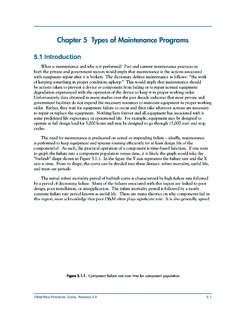Transcription of PROACTIVE VERSUS REACTIVE MEDICINE - The full extent …
1 P R O AC T IV E V E R S US R E AC T IV E ME D I C I NE. Unlike REACTIVE MEDICINE which waits for the disease to begin and then rushes in to resolve the symptoms, PROACTIVE MEDICINE provides the opportunity for maximizing prevention and aims to treat the root cause of the disease. Therefore, adults should visit their healthcare provider from time to time even if they are healthy. The purpose of these visits is to: Screen for diseases, Assess risk of future medical problems, Encourage a healthy lifestyle, Update vaccinations if necessary, and Build and maintain a relationship with the provider in case of an illness Annual physical exams are a vital part of a preventative illness measure which allows the provider to keep abreast of signs and symptoms that could lead to a serious illness.
2 Even if you feel fine, it is still important to see your healthcare provider regularly to check for potential problems. Most people who have high blood pressure do not even know it. The only way to find out is to have your blood pressure checked regularly. Likewise, high blood sugar and high cholesterol levels often do not produce any symptoms until the disease becomes advanced. For some people, the annual physical examination is a source of reassurance that they are as healthy as they feel. Others see it as an alarm system, to catch health problems before they become serious.
3 I encourage you to play an active role in your healthcare. Make sure you speak up with any questions or concerns about your health, regardless of how minor they may seem. Take warnings seriously and do not hesitate to ask for more informational resources. A healthy lifestyle and annual physical exam are two important preventative measures you can control. With regards to lifestyle modifications, keep the following in mind: 1) Don't smoke, and avoid secondhand smoke whenever possible. 2) Maintain an ideal body weight. 3) Get regular exercise. Brisk walking for just half an hour every day can be a big factor in weight control and in staying healthy.
4 4) Choose a diet low in animal fat and sodium, and rich in fruits, vegetables, whole grains, and low-fat or nonfat dairy products. Eat at least two servings of fish a week. 5) Keep alcohol consumption moderate: no more than one drink daily for a woman, two drinks for a man. If you are a heavy drinker, seek counseling, and cut back or quit. 6) Do monthly self-exams of your skin. Women should perform monthly self breast exams and men should perform monthly testicular exams. Any changes or concerns should be discussed with your healthcare provider. 7) Brush and floss daily to prevent dental disease.
5 During an annual physical exam, the provider will note your height, weight and vital signs including your blood pressure, heart rate, respiration rate, and temperature. Your provider will also inquire about important behaviors, like smoking, excessive alcohol use, sexual health, diet, and exercise. Your vaccination status will be checked and your personal and family medical history will be updated. You will also be given an opportunity to mention any recent complaints or concerns about your health. The typical physical exam includes the following main categories: 1) General Appearance: Your provider gathers a large amount of information about you and your health just by watching and talking to you.
6 How is your memory and mental quickness? Does your skin appear healthy? Can you easily stand and walk? 2) Head, Face, Eyes, Ears, Nose, and Throat: Your provider will assess these areas for any abnormalities or areas of concern. 3) Heart Exam: Listening with a stethoscope, your provider might detect an irregular heartbeat, a heart murmur, or note other clues to heart disease. 4) Lung Exam: Using a stethoscope, the provider listens for crackles, wheezes, or decreased breath sounds. These and other sounds are clues to the presence of heart or lung disease. 5) Abdominal Exam: Your provider can use a range of exam techniques to detect liver size and presence of abdominal fluid, listening for bowel sounds with a stethoscope, and palpating for tenderness.
7 6) Neurological Exam: Nerves, reflexes, balance, and mental state are assessed. 7) Dermatological Exam: Skin and nail findings could indicate a dermatological problem or disease somewhere else in the body. 8) Extremities Exam: Your provider will look for physical and sensory changes. Pulses can be checked in your arms and legs. Joints are assessed for abnormalities and also strength. 9) Fasting lab work: Blood and urine will be collected for routine lab tests. Male Physical Exam might also include: 1) Testicular exam: To check for lumps, tenderness, or changes in size.
8 Most men with testicular cancer notice a growth before seeing a provider. 2) Hernia exam 3) Prostate exam: Inserting a finger into the rectum lets a provider feel the prostate for its size and any suspicious areas. Female Physical Exam might also include: 1) Breast exam: Feeling for abnormal lumps may detect breast cancer or benign breast conditions. The provider will also check the lymph nodes in the underarm area and look for visual abnormalities of the breasts. 2) Pelvic exam: The pelvic exam allows examination of the vulva, vagina, and cervix. Routine checks for sexually transmitted infections are often done also.
9 A Pap test can screen for cervical cancer, and the ovaries (if present) will be palpated for abnormalities. Unfortunately, many patients do not receive the adult recommended screening tests or have annual physicals. One reason is the lack of continuity of care. If a patient sees providers at multiple locations keeping track of what services they have had can be difficult. Secondly, patients may not insist on getting preventive services due to lack of education on need or importance. Thirdly, with tests for some cancers, there is the embarrassment factor. Some patients may dread being tested for colon, prostate, or breast cancer and be relieved if the provider fails to mention it.
10 Lastly, some patients would rather not know if something is wrong. As a consumer of healthcare, the patient is responsible, in large part, for managing his/her own preventive care. Your primary care provider should be your partner for better health and ensure that you are informed of recommended screening tests and educate you on the purpose of those tests. If you need an annual physical, routine office visit, or are unsure of the recommended preventive tests for your age group, please call Cornerstone Primary Healthcare for an appointment. I would appreciate the opportunity to further discuss the tests listed below and help determine what needs to be done to get you up to date.







